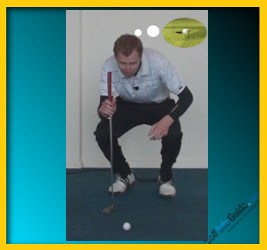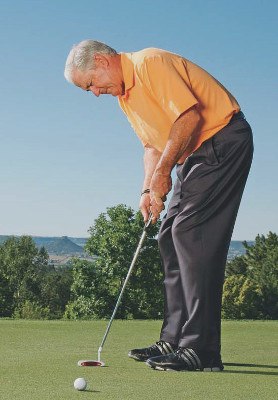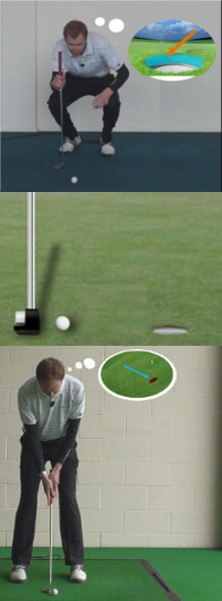
Golf instructors tend to give truth to the mean-spirited old adage, “Those who can, do; those who can't, teach.” Fact is, most of the game's best coaches turned to teaching after their playing careers flamed out.
Dave Stockton is the rare example of one who could do and teach.
As a player, Stockton won a pair of PGA Championships (1970 and '76), 11 PGA Tour titles and another 14 Champions Tour events, including three majors. He played on one victorious U.S. Ryder Cup team (1977), and captained another (1991).
Stockton's stock in trade, if you will, was a dead-eye putting stroke. Fittingly, teaching others to improve their putting has become his post-career calling card. (Stockton is a sought-after short-game guru as well.)
Stockton was doling out free advice to fellow pros long before teaching became his vocation. But when a series of operations knocked him out of Champions Tour commission in 2009, Stockton devoted himself to helping others master the art of putting.
His students have included Phil Mickelson, Annika Sorenstam and Rory McIlroy, who won the 2012 PGA Championship by eight strokes after Stockton imparted a few words of wisdom. Based on his pupils' performances before and after ringing up Stockton, his methods bear fruit in a very short time.
Stockton has authored a pair of well-received books, Unconscious Putting and Unconscious Scoring, and teams with sons Ronnie and Dave Jr. to offer instructional programs at clubs and teaching facilities. As of this writing, Stockton was preparing to introduce a teaching aid called the Spot Putting Secret.
It seems just a matter of time before Stockton's reputation as a teacher exceeds his achievements as a player. And that's saying something.
Famous students: Mickelson, Sorenstam, McIlroy, Matt Kuchar, Hunter Mahan, Yani Tseng
Core philosophy:
Stockton isn't shy about sharing his opinions on putting. His bottom line is that golfers -- amateurs and pros alike -- pay too much attention to stroke mechanics. He considers this an extension of their obsession with full-swing technique, but notes that the putting stroke is infinitely simpler.
Perhaps the most noticeable habit Stockton's students share is a pre-putt routine with no practice strokes. He believes that each putt should be judged mentally, and that practice strokes introduce a physical element that confuses the mind.
While Stockton primarily preaches feel and visualization, he insists on one technical detail: that the back of the left hand remain firm after impact. In other words, it should not rotate, cup, flip or break down once the ball has left the blade.
A few more pieces of Stockton's philosophy:
- Putts should be rolled, not hit.
- The stroke should begin within 2-3 seconds of settling into address.
- You should always visualize the ball dropping into the cup before putting.
- The best loft for a putter is 4°.
- Golfers should use a “forward press,” moving the hands toward the target before beginning the stroke.
Classic Stockton-style tip: To groove Stockton's flat-left-hand position, try this drill:
- Assume your putting stance with only your left hand on the putter.
- Place your right hand on top of your left shoulder.
- Make repeating strokes with the left hand, keeping the back of the hand pointing toward the target throughout.
The right hand serves to hold the left shoulder in place, ensuring that the putter stays low to the ground going back and through – another key Stockton concept.

A Great Teacher
Carving out any kind of career in the golf industry is an impressive accomplishment to be sure. Making it as a player is obviously one of the most-difficult things you can do in the game, as there are thousands of highly talented golfers around the world all competing for spots on the top tours. To succeed as a player requires not only hard work and talent, but also the mental strength to perform at your best when the pressure is on. There is certainly big money to be made in the world of professional golf, but that money does not come easy in any way.
While perhaps not quite as visible as professional golf, the world of golf instruction is also extremely competitive and difficult to enter. To succeed as a teacher requires an in-depth knowledge of golf technique, a love of the game, and an ability to connect with people in order to deliver your message. Some would say it is even harder to teach than it is to play, as teachers have to find ways to communicate properly with a wide-range of students – each of those students having his or her own unique traits, talents, and shortcomings. To be sure, teaching golf is not a career path that should be entered into lightly. One needs a great passion for the game as well as a love of helping other people succeed.
With all of that said, it becomes even more impressive to look at the storied career of Dave Stockton. It is hard to think of many people who have done more within this great game than Stockton, who was able to play at the highest level before then becoming a top-notch teacher as well. Rare are people who can both play and teach at a high level, which is why Stockton is so well-respected throughout the golf world. Although Stockton achieved his success as a player many years ago, it would be a shame for his record and achievements to fade into the past, as he deserves to be recognized right up there with the greats of the game.
In this article, we are going to take a look at some of the many accomplishments of Dave Stockton within the world of golf. Also, we are going to take a quick look at some of the main points of his teaching, specifically with relation to how those points can make you a better player. Any instruction that is contained below will be written from the perspective of a right handed golfer. If you play left handed, please take a moment to reverse the directions as necessary.

A Legendary Career
After attending the University of Southern California, Dave Stockton turned professional in golf in 1964. A quick success, he was a winner on the PGA Tour just three years later, recording his first title at the Colonial National Invitation. In all, he would go on to win a total of 25 professional tournaments, including 10 on the PGA Tour and 14 on the Champions Tour. Of those titles, two were major championships – the PGA Championship in 1970, and the PGA Championship again in 1976. He came close in other majors as well, finishing in a tie for 2nd at the 1974 Masters and the 1978 U.S. Open. A total of eight top ten finishes were recorded by Stockton in the majors, with half of those coming at The Masters. It should also be mentioned that three of his Champions Tour wins were major championships, with the last being the 1996 U.S. Senior Open.
One of the most-impressive things about the playing career of Dave Stockton is the span of years that he managed to cover from win to win. His first win, as mentioned above, was in 1967 on the PGA Tour. His final win – in 1997 on the Champions Tour – came more than 30 years later. While it is not uncommon for golfers to have long careers, it is never easy to perform at a high level for that length of time in any discipline. Dave Stockton was at or near the top of the game for 30 years, making his career one of the most-notable in golf history.
Of course, as you already know, the story does not end there. While Dave Stockton certainly could have been satisfied with his performance on the course, he decided to create another legacy within golf as a top-flight instructor. In fact, a whole new generation of golfers are familiar with Stockton's name and accomplishments thanks to his teaching career. Plenty of professional golfers get into instruction at one point or another, either after they are done playing or while they are still going, but few do so with the success of Dave Stockton.
The most-recognized piece of Dave Stockton's instructional career is certainly his book, Unconscious Putting. Stockton was known as one of the game's best putters during his time on tour, so it only makes sense that he would go on to help others with this challenging part of the game. Countless golfers struggle to find consistency on the greens, which is why so many strokes are lost by amateur golfers through mistakes like three-putting and missing short putts. If you are someone who has struggled from time to time with the ability to make putts, picking up a copy of Stockton's successful book is an easy decision.
When average golfers turn to professionals for advice, that advice usually relates to the full swing. People see pro golfers hit beautiful shots on television or in person, and they want to imitate those shots for themselves. While there is nothing wrong with trying to improve on your full swing, the better approach is to learn about the short game from the pros. Most of your shots are going to be played from inside of 100 yards, so you should be most-concerned with improving this part of your game. Playing better from close to the hole – especially on the putting green – is the quickest and most-effective way to lower your scores.

Who Cares?
One of the points that Dave Stockton makes when teaching putting is the idea of not really caring about whether the ball goes in or not. That might sound a bit silly at first, but it is actually one of the best tips you can receive with regard to your performance on the greens. Most players try as hard as possible to force the ball to go in the hole – but you can't force the game of golf. By changing your mindset to one that is okay with the reality that some of your putts are not going to fall in, you will actually have a much better chance of finding the bottom of the cup.
So, if you aren't focused on making your putt, what is it that you are thinking about when standing over the ball? Rolling your putt smoothly off the face of the putter. Stockton talks about how there is no real 'hit' in the putting stroke – rather, the ball should just roll gently off the putter and toward the target time after time. If you put a good roll on the ball, and you combine that roll with a good read and the right speed, you should be successful more often than not.
In many ways, this kind of instruction is all about attitude. You have to separate out the process from the results if you are going to think this way on the golf course. For many people, a putt is considered to be a failure if it does not go in. However, that way of thinking is a bit misleading, as there are plenty of things that can go wrong with a putt that are out of your control. For instance, you could hit a great putt that happens to bounce off of a small bump in the green, causing the putt to miss. Is that your fault? No – of course not. You hit a great putt, and you should be happy with your putt even though the ball didn't wind up going in. They aren't all going to go in, even for a great putter like Dave Stockton, so you need to learn to evaluate your performance independent of the results.
When you take a more-relaxed attitude to the results of your putts, it is very likely that some of your other mechanics will improve as a result. For instance, attempting to roll the ball nicely up to the hole without trying to 'force' it to go in should lead to a lighter grip pressure on the club. You probably know already that light grip pressure is great for putting, yet you may squeeze the club too tight as you are trying hard to knock the putt in. Let go of all of that extra effort, relax as you stand over your putts, and roll the ball gently up toward the cup each and every time. It will take some practice to learn how to stick with this way of thinking, but your performance should be improved over time as a result of making this mental change.

Speed Control
Another one of the key elements of Dave Stockton's teaching on putting is the issue of speed control. Specifically, Stockton likes to promote the idea of rolling the ball with what some golfers refer to as 'dead weight' - in other words, speed that will bring the ball to a stop close to the hole if it doesn't go in. Rather than putting with speed that would ram the ball into the back of the cup, Stockton teaching putting speed that would have the ball fall in over the front edge as it runs out of speed.
Generally speaking, this is a great way for amateur golfers to putt. Many players get so caught up in trying to make their current putt that they forget about leaving the ball in a position to make the next putt as easy as possible. When you putt with great speed control, rarely will you have to work very hard on your second putt. If the first doesn't fall in, you should be able to tap the ball in with your next putt and move on. In addition to greatly reducing your number of three putt greens, putting with 'dead weight' can offer other benefits as well, such as those listed below -
- Make the hole bigger. When the ball is rolling slowly around the cup, you will effectively be making the hole bigger than it would be when you hit putts at a higher speed. When the ball is rolling fast, it is likely to spin out when it hits the edges of the cup. However, with very little speed left on your putts when they get to the hole, those edges will be more forgiving and the ball will be more likely to fall in rather than spinning out. If you feel like your putts are constantly hitting the edges of the cup without falling in, it is very likely that you are using too much speed.
- Simplify your reads. By using the same type of speed on every putt that you hit, the process of reading the line of your putts will become easier. There are two elements to any putt that you hit – line and speed – and you need to get both of them right in order to actually make the putt. If you are changing your speed frequently, you will have to recalibrate your reads in order to match up with the speed you have picked out. Using that plan is unnecessarily complicated, and it will likely cause you to perform inconsistently on the greens. Instead, stick with the same speed for every putt that you hit – trying to die the ball within a foot or so of the cup – and then plan on that speed as you select your line.
- Save your nerves. Every time you face a testy three or four footer to save par (or bogey), you have to spend quite a bit of mental energy to hold your nerve and make the putt. There is nothing wrong with having to do that once or twice in a round, but that chore can quickly become draining when you need to conquer these kinds of putts hole after hole all day long. If you putt with aggressive speed, you will see a lot of comeback putts that require your full attention and effort. You might not mind so much over the first couple of holes, but that job will quickly get old and you might find that you lose focus as the holes go by. Save your mental energy by putting with dead weight and keep your mind free to focus on positive thoughts.
It is true that you will need to spend plenty of time practicing your speed control if you want to consistently bring the ball to a stop right next to the cup. However, if you are willing to put in that time, you can be rewarded with putting performance which is far beyond what you have been able to achieve previously. Speed control is the name of the game on the greens, so dedicate yourself to this part of the game and watch your scores gradually start to fall.

Putting Over a Spot
This last point that we are going to highlight is one that is used by Dave Stockton in addition to a number of other noted short game teachers. The idea is relatively simple – rather than trying to just roll the ball into the hole, you are going to try to roll the ball over a spot on the green that will allow the ball to eventually find the cup. In other words, you are going to pick an intermediate target to guide your stroke – if you can roll the putt over that intermediate target time and time again, you should have a good chance to make more than your share of putts throughout the course of a round.
There are a number of positive aspects to using this plan to guide your putting. First, this is a great way to take your focus off of making the putt. Once you have your read and you have picked out your spot, you can think simply about hitting that spot – and your mind will take a step back from thinking only about the hole. The importance of mindset was highlighted earlier in this article, and this is another point that will help you move in the right direction with regard to how you think about your putts.
Another positive aspect of putting over a spot is how this method forces you to think about the entire read of the putt from start to finish. It is easy to fall into the trap of only reading the last few feet, but the entire length of the putt is important. When you have to select a spot to putt over along the way, you will need to consider the full distance of the roll as you read the green. That added attention to detail just might help you make better reads, meaning you should be a better overall putter in the end.
If you decide to put this putting method into practice, the first thing you will need to do is decide where you are going to look for an intermediate target. Some players like to have a target that is immediately in front of the ball - as close as a couple of inches – while other players like to look a foot or two out in front of them. You can decide for yourself what kind of system you are comfortable with, but make sure your spot is close enough to the ball for you to see it easily at address. If the point you are using for your spot gets too far out in front of the ball, you will lose the effect as you won't be able to see it in order for it to hold your attention.
On the course, you are going to need to learn how to pick out spots that you can identify quickly as you are standing over the ball. You might think that a putting green is just a solid green surface, but when you look closely you will find that there are plenty of variations within the surface that you can use to serve as target points. There are usually some discolored spots on the green, or blades of grass that are slightly longer than the rest. When you look close, you will find that you have no shortage of spots that can be used for this purpose. Of course, it is a good idea to rehearse this type of putting on the practice green before giving it a try during an actual round. You should be able to get comfortable with this method after just a few practice sessions, at which time you will be ready to integrate it into the way you putt on the course.
For any golfer, there is a lot to be learned from the impressive career of Dave Stockton. Not only was Stockton able to rise to the top of the game as a two-time major champion, he has also built a notable second career as a golf teacher. Every golfer would benefit by putting at a higher level, and there are few people in the world as qualified to teach putting as Dave Stockton. His book is highly recommended reading for any serious golfer, as the instruction provided within has the potential to quickly shave valuable strokes from your scores. It is fun to be able to hit great shots from tee to green, but having the ability to make your putts when you reach the putting surface is what this game is all about. Good luck!






